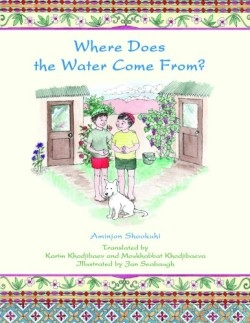Where Does the Water Come From?
As two boys search for the source of the water that ordinarily flows through their yards they learn about more than water. Asad and Samad discover that nobody is all good or all bad.
Asad and Samad live in Tajikistan. They enjoy wading and splashing in Asad’s water channel but one day the water doesn’t come. “Let’s go and release the water ourselves” Asad says. In nine chapters these two barefoot boys and Asad’s puppy follow the water channels through neighbors’ yards and several villages. The boys meet interesting people and get into various difficulties. At the end of the book a page informs readers about Tajikistan an independent country that was previously part of the Soviet Union.
On their travels the boys encounter a man named Tavakkalhoja who has awoken to find mulberry stains on his face and sheep horns on his head; he falsely blames the boys. They meet him several more times throughout the story. One of Jan Seabaugh’s delightful watercolor drawings depicts the boys attempting to pull Tavakkalhoja out of a large slippery-sided canal after he rescued a girl. As Tavakkalhoja holds one end of a broken-off tree branch the boys pull on the other end. In this episode the boys see another aspect of his personality. In spite of the inconsiderate way he has treated them Asad and Samad learn that Tavakkalhoja is actually kindhearted.
The story provides readers with a peek into a lesser-known culture. For example the author describes the mirab as “the official whose job it is to regulate the water flow to the community ditches.”
The ages of Asad and Samad are unclear but the story will be entertaining for seven- to eleven-year-olds. Children under fourth grade may have difficulty reading it. A couple errors in syntax may be the result of translation errors. For example as the boys try to teach Asad’s cat to swim the text states “The boys prepared to launch her into the water.” But other statements about the cat use the pronoun “he.” Numerous expected spaces in the print are missing mainly non-problematic ones between a period or comma and opening quotation marks for the next sentence or clause.
Where Does the Water Come From? is the first book in author Aminjon Shookuhi’s trilogy of the same name. Shookuhi whose real name is Aminjon Khodjibaev was a prominent Tajik writer of drama novels and poetry including children’s poetry collections. This native of Tajikistan received the Rudaki Award and posthumously the title of National Writer of Tajikistan.
Seabaugh is a writing and English literature instructor at Saint Mary’s College near South Bend Indiana. This college’s Cushwa-Leighton Library exhibited the watercolor drawings that Seabaugh provided for this book and for Doctor Ouch which she illustrated and translated.
The translators Moukhabbat Khodjibaeva and Karim Khodjibaev are the author’s daughter-in-law and son. Khodjibaeva with master’s degrees in information technology and cinema arts has made contributions to Russian and Persian language projects. Khodjibaev has a master’s degree in linguistics and certification in translation and interpretation. This professional linguist co-authored Tajik-English Dictionary.
Reviewed by
Norma D. Kellam
Disclosure: This article is not an endorsement, but a review. The publisher of this book provided free copies of the book and paid a small fee to have their book reviewed by a professional reviewer. Foreword Reviews and Clarion Reviews make no guarantee that the publisher will receive a positive review. Foreword Magazine, Inc. is disclosing this in accordance with the Federal Trade Commission’s 16 CFR, Part 255.

